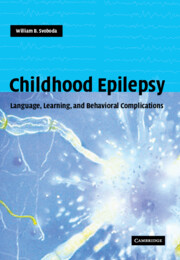Book contents
- Frontmatter
- Contents
- Preface
- Glossary
- 1 Looking ahead
- Part I Speech and language problems
- 2 Language: the challenge
- 3 Speech, language, and communication
- 4 Speech and language problems in epilepsy
- 5 Seizure types and speech and language risks
- 6 Language regression with epilepsy syndromes
- 7 Other epilepsy language syndromes
- 8 Seizure-management effects
- 9 Evaluation of speech and language problems
- 10 Management of speech and language problems in epilepsy
- 11 Behavior consequences
- Part II Learning problems
- Part III Behavior problems
- Index
- References
7 - Other epilepsy language syndromes
from Part I - Speech and language problems
Published online by Cambridge University Press: 26 October 2009
- Frontmatter
- Contents
- Preface
- Glossary
- 1 Looking ahead
- Part I Speech and language problems
- 2 Language: the challenge
- 3 Speech, language, and communication
- 4 Speech and language problems in epilepsy
- 5 Seizure types and speech and language risks
- 6 Language regression with epilepsy syndromes
- 7 Other epilepsy language syndromes
- 8 Seizure-management effects
- 9 Evaluation of speech and language problems
- 10 Management of speech and language problems in epilepsy
- 11 Behavior consequences
- Part II Learning problems
- Part III Behavior problems
- Index
- References
Summary
In addition to the acquired aphasia with epilepsy syndromes, there are other syndromes in which the loss or non-development of language skills, along with the emergence of epilepsy, may be prominent.
Perisylvian-opercular syndromes
The perisylvian syndromes consist of a congenital type and an acquired type, both presenting with pseudobulbar palsy and epilepsy. Language remains intact, but speech is inhibited.
Congenital perisylvian syndrome
The congenital bilateral perisylvian (opercular) syndrome presents with a developmental pseudobulbar palsy with epilepsy and mild to moderate mental retardation. Often, other congenital defects are found. Imaging studies reveal bilateral perisylvian migration abnormalities (Kuzniecky et al., 1989; Kuzniecky et al., 1991a; Kuzniecky et al., 1991b; Kuzniecky et al., 1993a; Kuzniecky et al., 1993b; Kuzniecky et al., 1994).
Clinical
The syndrome becomes apparent in infancy or early childhood as dissociation between automatic and voluntary movements of the mouth and face. Characteristic of this syndrome is that severe voluntary oromotor problems are noted, with preserved non-voluntary emotional movements. The child demonstrates developmental delays (60%) and mild to moderate mental retardation (50–80%). Dysarthria or, in severe cases, mutism with preserved comprehension is seen.
Seizures are usually seen (87–90%), often beginning at age eight to 12 months. Some patients (20%) have a history of infantile spasms in the first few months of life. Generalized seizures are common (80%). Absence seizures may be seen. Head drops and atonic and tonic seizures occur often (70%). Partial epilepsy may also be noted (9%). A mixed seizure disorder is seen in about half the patients (40–60%).
- Type
- Chapter
- Information
- Childhood EpilepsyLanguage, Learning and Behavioural Complications, pp. 101 - 115Publisher: Cambridge University PressPrint publication year: 2004



